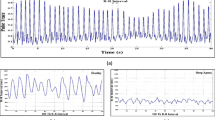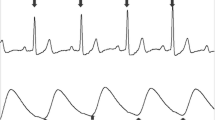Abstract
It would often be desirable to obtain the respiratory rate during everyday conditions without obtaining an additional respiratory trace. This study investigates the agreement between respiratory rate assessed from the electrocardiogram (ECG) and the reference respiratory rate derived from a nasal/oral airflow (AF). Nasal/oral airflow and a Holter ECG were recorded in 52 healthy subjects (26 males, age range: 25.4–85.4 years) during everyday conditions for at least 10 h, including night-time sleep. The respiratory rate was assessed for each 5-min epoch (1) using respiratory sinus arrhythmia (RSA), (2) utilizing the respiration induced variations of the R-wave amplitude (ECG derived respiration (EDR)). The agreement with respect to AF was quantified using the average/std and the concordance correlation coefficient ρc. For RSA and EDR the difference with respect to AF was 0.2 cpm (std: 0.6 cpm) during sleep and −0.2 cpm (std: 1.0 cpm) during wake time. During sleep the RSA-approach performed best for subjects ≤50 years (ρc = 0.79) and worst for subjects >50 years (ρc = 0.41). The correlation of the EDR-approach was ρc = 0.73 for both groups. In conclusion, the respiratory rate may be assessed with reasonable agreement by both methods in younger subjects, but EDR should be preferred in the elderly.






Similar content being viewed by others
Notes
As the prevalence of obstructive sleep apnea syndrome (OSAS) in a general population with normal BMI is rather low (Germany: approx. 2%) we did not screen specifically for OSAS. As each respiratory trace was inspected visually to find artefacts, symptoms of OSAS were found in one subject.
Definition: bpm (beats per minute) = min−1 = (60 s)−1.
Definition: cpm (cycles per minute) = min−1 = (60 s)−1.
References
Bailon R., Sornmo L., Laguna P. 2006 A robust method for ECG-based estimation of the respiratory frequency during stress testing. IEEE Trans. Biomed. Eng. 53:1273–1285. doi:10.1109/TBME.2006.871888
Bailon R., Sornmo L., Laguna P. 2006 ECG-derived respiratory frequency estimation. In, G. D. Clifford, F. Azuaje, P. E. McSharry (eds). Advanced methods and tools for ECG data analysis. Boston, MA: Artech House, pp. 215–244
Berntson G. G., Bigger J. T., Eckberg D. L., Grossman P., Kaufmann P. G., Malik M., Nagaraja H. N., Porges S. W., Saul J. P., Stone P. H., van der Molen M. W. 1997 Heart rate variability: Origins, methods, and interpretive caveats. Psychophysiology 34:623–648. doi:10.1111/j.1469-8986.1997.tb02140.x
Bettermann H., Cysarz D., Van Leeuwen P. 2000 Detecting cardiorespiratory synchronization by respiratory pattern analysis of heart period dynamics: the musical rhythm approach. Int. J. Bifurcat. Chaos 10:2349–2360
Bettermann H., Engelke P., Van Leeuwen P., Heckmann C. 1996 Determination of respiratory frequency from respiratory sinus arrhythmia. Biomed. Tech. (Berl) 41:319–323
Casolo G., Balli E., Taddei T., Amuhasi J., Gori C. 1989 Decreased spontaneous heart rate variability in congestive heart failure. Am. J. Cardiol. 64:1162–1167. doi:10.1016/0002-9149(89)90871-0
Cysarz D., Büssing A. 2005 Cardiorespiratory synchronization during Zen meditation. Eur. J. Appl. Physiol. 95:88–95. doi:10.1007/s00421-005-1379-3
de Chazal P., Heneghan C., Sheridan E., Reilly R., Nolan P., O'Malley M. 2000 Automatic classification of sleep apnea epochs using the electrocardiogram. Comput. Cardiol. 27:745–748
Fallen E. L., Kamath M. 1995 Circadian rhythms of heart rate variability. In Heart rate variability, edited by M. Malik, A. J. Camm. Armonk NY: Futura Publishing, pp. 293–309
Grossman P., Wilhelm F. H., Spoerle M. 2004 Respiratory sinus arrhythmia, cardiac vagal control and daily activity. Am. J. Physiol. Heart Circ. Physiol. 287:H728–H734. doi:10.1152/ajpheart.00825.2003
Hirsch J. A., Bishop B. 1981 Respiratory sinus arrhythmia in humans: how breathing patterns modulates heart rate. Am. J. Physiol. 241:H620–H629
Hoyer D., Hader O., Zwiener U. 1997 Relative and intermittent cardiorespiratory coordination. IEEE Eng. Med. Biol. Mag. 16:97–104. doi:10.1109/51.637123
Kuo T. B., Lin T., Yang C. C. H., Li C. L., Chen C. F., Chou P. 1999 Effect of aging on gender differences in neural control of heart rate. Am. J. Physiol. 277:H2233–H2239
Leder U., Hoyer D., Sommer M., Baier V., Haueisen J., Zwiener U., Figulla H. R. 2000 Cardiorespiratory desynchronisation after acute myocardial infarction. Z. Kardiol. 89:630–637. doi:10.1007/s003920070214
Lehofer M., Moser M., Hoehn-Saric R., Mcleod D., Hildebrandt G., Egner S., Steinbrenner B., Liebmann P., Zapotoczky H. G. 1999 Influence of age on the parasympatholytic property of tricyclic antidepressants. Psychiatry Res. 85:199–207. doi:10.1016/S0165-1781(99)00005-0
Lin L. I. 1989 A concordance correlation coefficient to evaluate reproducibility. Biometrics 45:255–268. doi:10.2307/2532051
Lin L. I. 1992 Assay validation using the concordance correlation coefficient. Biometrics 48:599–604. doi:10.2307/2532314
Lipsitz L. A., Hashimoto F., Lubowsky L. P., Mietus J., Moody G. B., Appenzeller O., Goldberger A. L. 1995 Heart rate and respiratory rhythm dynamics on ascent to high altitude. Br. Heart J. 74:390–396. doi:10.1136/hrt.74.4.390
Malpas S. C., Purdie G. L. 1990 Circadian variation of heart rate variability. Cardiovasc. Res. 24:210–213. doi:10.1093/cvr/24.3.210
Mazzanti B., Lamberti C., de Bie J. 2003 Validation of an ECG-derived respiration monitoring method. Comput. Cardiol. 30:613–616. doi:10.1109/CIC.2003.1291230
Moody G. B., Mark R. G., Bump M. A., Weinstein J. S., Berman A. D., Mietus J. E., Goldberger A. L. 1986 Clinical validation of the ecg-derived respiration (edr) technique. Comput. Cardiol. 13:507–510
Moody G. B., Mark R. G., Zoccola A., Mantero S. 1985 Derivation of respiratory signals from multi-lead ecgs. Comput. Cardiol. 12:113–116
Moser M., Lehofer M., Hildebrandt G., Voica M., Egner S., Kenner T. 1995 Phase- and frequency coordination of cardiac and respiratory function. Biol. Rhythm Res. 26:100–111
Moser M., Lehofer M., Sedminek A., Lux M., Zapotoczky H. G., Kenner T., Noordergraaf A. 1994 Heart rate variability as a prognostic tool in cardiology: A contribution to the problem from theoretical point of view. Circulation 90:1078–1082
Naifeh K. H., Severinghaus J. W., Kamiya J. 1987 Effect of aging on sleep-related changes in respiratory variables. Sleep 10:160–171
Penzel T., McNames J., Murray A., de Chazal P., Moody G., Raymond B. 2002 Systematic comparison of different algorithms for apnoea detection based on electrocardiogram recordings. Med. Biol. Eng. Comput. 40:402–407. doi:10.1007/BF02345072
Pikkujamsa S. M., Makikallio T. H., Sourander L. B., Raiha I. J., Puukka P., Skytta J., Peng C. K., Goldberger A. L., Huikuri H. V. 1999 Cardiac interbeat interval dynamics from childhood to senescence - Comparison of conventional and new measures based on fractals and chaos theory. Circulation 100:393–399
Raschke, F. Spectral analysis of autonomous rhythms during night sleep. In: XIII International Conference – Proceedings of the International Society for Chronobiology, edited by F. Halberg, L. E. Scheving, E. W. Powell, and D. K. Hayes. Milano: Il Ponte, 1981, pp. 309–316.
Reilly K. J., Moore C. A. 2003 Respiratory sinus arrhythmia during speech production. J. Speech Lang. Hear. Res. 46:164–177. doi:10.1044/1092-4388(2003/013)
Spicuzza L., Bernardi L., Calciati A., Di Maria G. U. 2003 Autonomic modulation of heart rate during obstructive versus central apneas in patients with sleep-disordered breathing. Am. J. Respir. Crit. Care Med. 167:902–910. doi:10.1164/rccm.200201-006OC
Stein P. K., Kleiger R. E., Rottman J. N. 1997 Differing effects of age on heart rate variability in men and women. Am. J. Cardiol. 80:302–305. doi:10.1016/S0002-9149(97)00350-0
Task Force of the European Society of Cardiology, the North American Society of Pacing and Electrophysiology. 1996 Heart rate variability: standards of measurement, physiological interpretation, and clinical use. Circulation 93:1043–1065
Thayer J. F., Peasley C., Muth E. R. 1996 Estimation of respiratory frequency from autoregressive spectral analysis of heart period. Biomed. Sci. Instrum. 32:93–99
Thayer J. F., Sollers J. J. III, Ruiz-Padial E., Vila J. 2002 Estimating respiratory frequency from autoregressive spectral analysis of heart period. IEEE Eng. Med. Biol. Mag. 21:41–45. doi:10.1109/MEMB.2002.1032638
Tulppo M. P., Makikallio T. H., Seppanen T., Laukkanen R. T., Huikuri H. V. 1998 Vagal modulation of heart rate during exercise: effects of age and physical fitness. Am. J. Physiol. 274:H424–H429
Wallis L. A., Healy M. J., Undy B., Maconochie I. 2005 Age related reference ranges for respiration rate and heart rate from 4 to 16 years. Arch. Dis. Child. 90:1117–1121. doi:10.1136/adc.2004.068718
Acknowledgments
DC and MK were supported by grants of the Software AG Stiftung, Darmstadt, Germany. DC was also supported by grants of the Rudolf Steiner Fonds, Nürnberg, Germany. RZ and MK acknowledge financial support from the Humanus-Institut e.V., Kandern, Germany.
Author information
Authors and Affiliations
Corresponding author
Rights and permissions
About this article
Cite this article
Cysarz, D., Zerm, R., Bettermann, H. et al. Comparison of Respiratory Rates Derived from Heart Rate Variability, ECG Amplitude, and Nasal/Oral Airflow. Ann Biomed Eng 36, 2085–2094 (2008). https://doi.org/10.1007/s10439-008-9580-2
Received:
Accepted:
Published:
Issue Date:
DOI: https://doi.org/10.1007/s10439-008-9580-2




